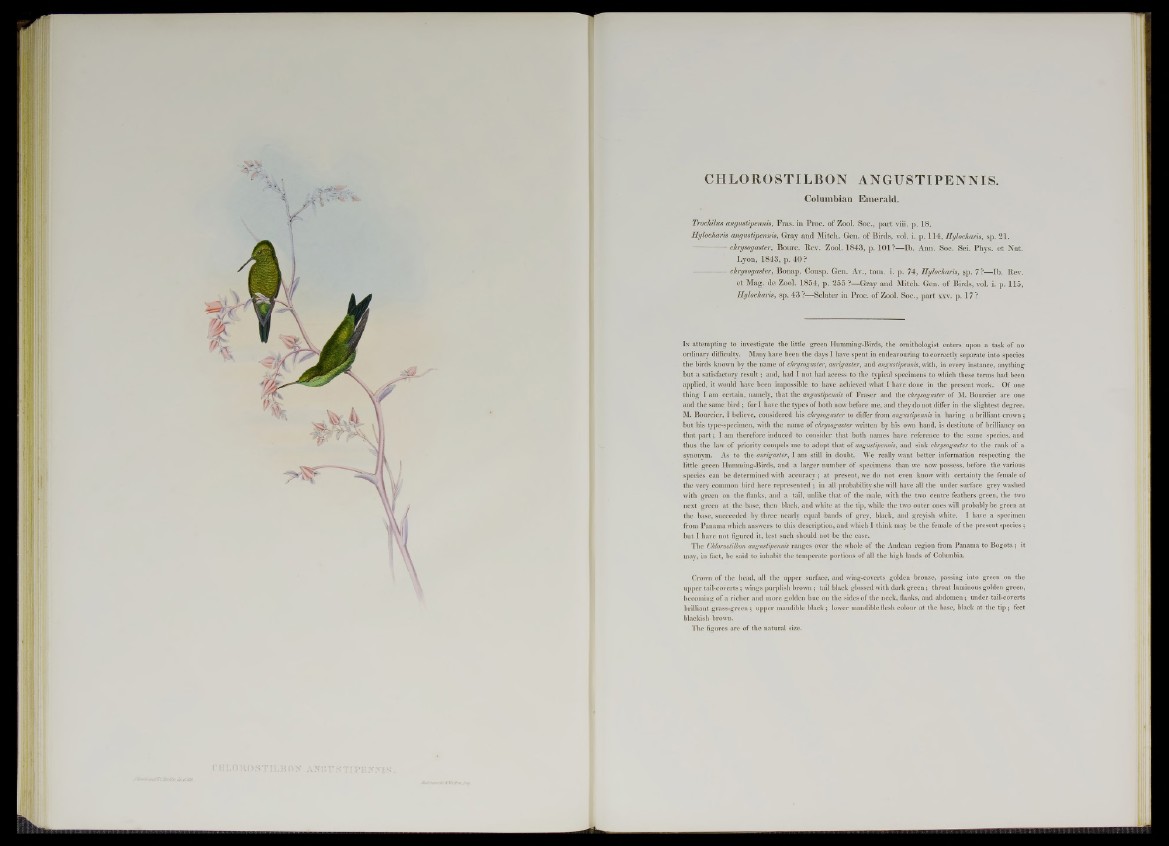
Columbian Emerald.
Trochilus angmtipennis, Fras. in Proc. of Zool. Soc., p a rt viii. p. 18.
Hylochai'is angmtipennis, Gray and Mitch. Gen. o f Birds, vol. i. p. 114, Hglocharis, sp. 21.
— chrysogaster, Bourc. Rev. Zool. 1843, p. 101 ?— lb . Ann. Soc. Sci. Phys. e t Nat.
Lyon, 1843, p. 4 0 ?
— chrgsogaster, Bonap. Consp. Gen. Av., tom. i. p. 74, Hylocharis, §p. 7 ?— lb . Rev.
e t Mag. de Zool. 1854, p. 255 ?— Gray and Mitcb. Gen. o f Birds, vol. i. p. 115,
Hylocharis, sp. 4 3 ?— Sclater in Proc. of Zool. Soc., p a rt xxv. p. 1 7 ?
I n attempting to investigate the little green Humming-Birds, the ornithologist enters upon a task of no
ordinary difficulty. Many have been the days I have spent in endeavouring to correctly separate into species
the birds known by the name of chrysogaster, aurigaster, and angustipennis, with, in every instance, anything
but a satisfactory result; and, had I not had access to the typical specimens to which these terms had been
applied, it would have been impossible to have achieved what I have done in the present work. Of one
thing I am certain, namely, that the angustipennis of Fraser and the chrysogaster of M. Bourcier are one
and the same b ird ; for I have the types of both now before me, and they do not differ in the slightest degree.
M. Bourcier, I believe, considered his chrysogaster to differ from angustipennis in having a brilliant crown;
but his type-specimen, with the name of chrysogaster written by his own hand, is destitute of brilliancy on
that p a rt; I am therefore induced to consider that both names have reference to the same species, and
thus the law of priority compels me to adopt that of angustipennis, and sink chrysogaster to the rank of a
synonym. As to the aurigaster, I am still in doubt. We really want better information respecting the
little green Humming-Birds, and a larger number of specimens than we now possess, before the various
species can be determined with accuracy; at present, we do not even know with certainty the female of
the very common bird here represented ; in all probability she will have all the under surface grey washed
with green on the flanks, and a tail, unlike that of the male, with the two centre feathers green, the two
next green at the base, then black, and white at the tip, while the two outer ones will probably be green at
the base, succeeded by three nearly equal bands of grey, black, and greyish white. I have a specimen
from Panama which answers to this description, and which I think may be the female of the present species ;
but I have not figured it, lest such should not be the case.
The Chlorostilbon angustipennis ranges over the whole of the Andean region from Panama to Bogota; it
may, in fact, be said to inhabit the temperate portions of all the high lands of Columbia.
Crown of the head, all the upper surface, and wing-coverts golden bronze, passing into green on the
upper tail-coverts; wings purplish brown ; tail black glossed with dark green; throat luminous golden green,
becoming of a richer and more golden hue on the sides of the neck, flanks, and abdomen; under tail-coverts
brilliant grass-green ; upper mandible black; lower mandible flesh colour at the base, black at the tip ; feet
blackish brown.
The figures are of the natural size.